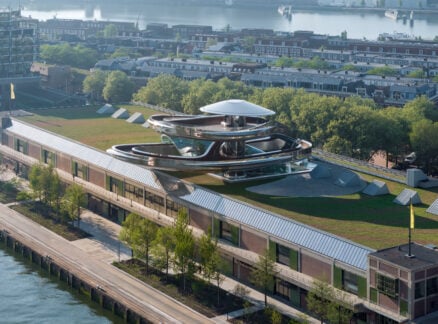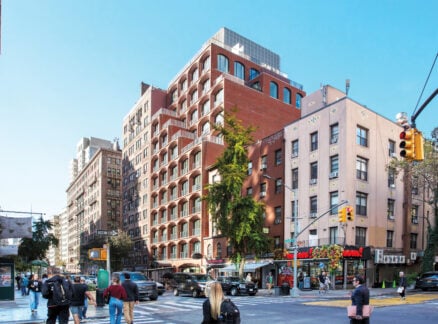February 22, 2007
The Indomitable Work Space
Experts said technology would render it a dinosaur, but the lowly cubicle lumbers on.
The other day I visited a friend who has a particularly elegant office designed by Gwathmey Siegel in the Seagram Building. My friend, who considers himself an enlightened client, had instructed the architects to honor Mies and the original spirit of the building as best they could. When the work was done, he hung a set of Ezra Stoller photographs of the building in his conference room to underscore the connection between his new space and what Mies had produced in 1958. We looked at a black-and-white picture of one of the building’s original interiors, which showed an elaborate electric typewriter atop a sleek desk whose surface was a floating white plane. “I guess things really have changed since then,” my friend said.
Well, yes and no. Of course the typewriters are gone, as dated as the 1954 Buick in the image of Seagram’s exterior that also hangs on the wall. But how different are most offices right now from those 1950s spaces that we see in pictures like this? Or in those early photographs of the Florence Knoll interiors in the CBS Building, or in movies like The Apartment?
Today’s offices are messier of course (and only some of that is because those iconic spaces were cleaned up for the photographers). But there is now more paper, just as there are more books, more magazines, more newspapers, more CDs, more telephones. The most up-to-date office of the 1950s had an electric typewriter; even the photocopier was not yet commonplace. Now there are copying machines and faxes and scanners and printers as well as computers, and none of these machines save paper as they were supposed to—they generate more of it. Everybody gets a copy of everything. E-mails save paper until they are printed out. The easier it is to make copies, the more copies are made, and the more paper there is. Technology has not ended the spread of paper but has increased it.
Technology has also failed to transform something else: our sense of private work space. By now we were supposed to be in the age of the virtual office, where no one would need individualized space, and no one would view an office as much of anything except a docking station for you and your laptop to pass through. In the virtual office you wouldn’t need your own personal space because you wouldn’t be in the office enough to make use of it. People would work at home, or wherever they happened to be, and technology would provide all the connection to other people that they needed. When you had to show up, you would just plug into whatever cubicle was available. The offices would be designed to be as interchangeable as fitting rooms at the Gap.
Gaetano Pesce’s celebrated virtual office for the advertising agency Chiat/Day in New York, the most creative attempt to respond to this new trend, now looks even more like a period piece than those early Seagram photographs. The concept didn’t work because people came into the office more than the technocrats had predicted, and when they were there they felt entitled to a place of their own. It didn’t need to be an elaborate corner office; what mattered is that it was theirs, a space in which their innately human nesting instinct could be quietly expressed.
Beyond some small measure of individuality and personal expression, people seem to want a degree of privacy in their work spaces. This is why another old warhorse, the cubicle, has never disappeared entirely. It probably never will—despite frequent predictions of its demise—because cubicles are the perfect middle ground between private offices, which are impractical and waste space, and entirely open rooms of desks, which lack privacy and are woefully inefficient because they require people to keep files, books, and personal possessions somewhere else. I don’t hear people using the phrase “office landscape” much anymore, but the reality is that the fundamentals of the cubicle—a waist-high partition, allowing privacy when seated and a little bit of wall space, and a built-in countertop with lots of horizontal surface—are absolutely reasonable and right.
When offices consisted entirely of enclosed private rooms and open bull-pen-like work spaces, the class divide was painfully clear. The important people worked in private—and indeed had so much privacy that they could not easily interact with one another. The unimportant people had no privacy whatsoever and were forced to interact with each other, even when they had no need to. Cubicles represent a kind of in-between state, a graceful balance between the aristocracy and the peonage. Because most of the people are in the same general area, there is a sense of unity, of shared work space and, by implication, shared mission. The structure of the cubicle also grants the worker a reasonable level of dignity, something that is lacking in a desk sitting out in the open.
The problem, of course, is that most cubicle systems are designed in such a way as to offset their potentially good qualities. Like suburban tract houses—which were conceived with a similar intention, to grant a kind of dignity to the individual family—the office cubicle now seems less a good than a blight: the Levittown of the work space. There are too many of them. They appear to go on forever, and most of them are dreary to boot. And unlike suburban houses, which can be tweaked for a bit of individual expression (by now there are almost no original houses left in Levittown), cubicles don’t get altered. There is rarely anything other than a few family pictures or a child’s drawing tacked to the partition to distinguish one from the other. I’d love to hail the cubicle as a piece of democratic design that elevates even the lowest office worker by giving him or her a semiprivate work space. It accomplishes that but to little purpose, alas, since the world it evokes is not one of individuality but of banal conformity.





